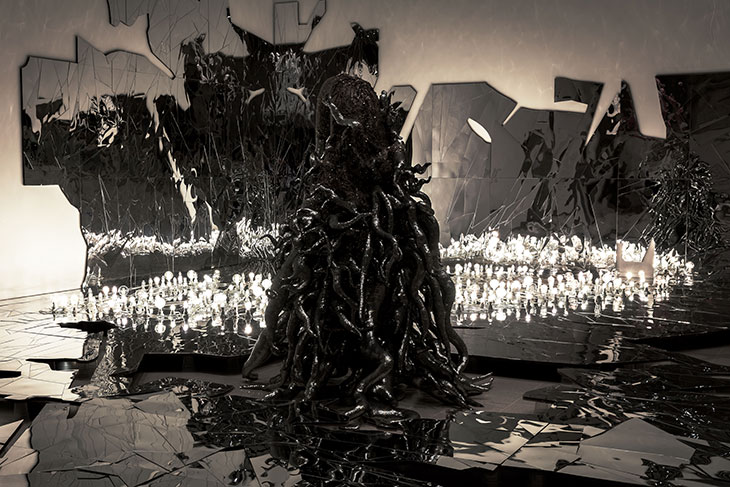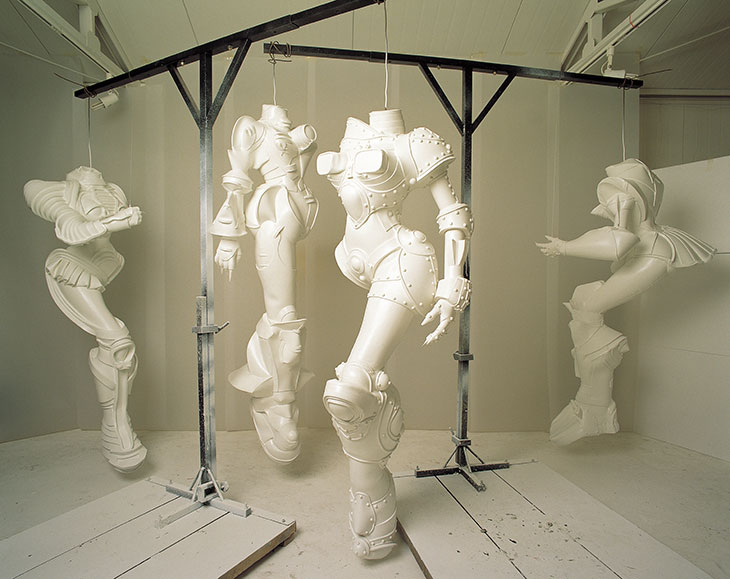In an essay called ‘Beauty and Trauma’ (2000), Lee Bul tells a story from her childhood in South Korea. She was standing at a pedestrian crossing, waiting for the lights to change; as she stood there, she gazed across the road at a beautiful bakery, and its ‘sumptuously decorated cakes’ – almost a work of art. A scooter drifted into the scene, across Lee’s path, carrying a gorgeous young couple who seemed to have come from some ‘radiant, ethereal dimension’. They glided through the red light, into oncoming traffic, and then, in a heartbeat, Lee was staring at the aftermath. Their blood and flesh was spattered all over the road; the woman was thrown into the bakery window, ‘toppling over the cakes, landing face down in the vast heap of sweet, creamy confection now spattered with her blood’.
Lee would never lose her fascination with the fragile boundary between beauty and horror – as is shown by ‘Crashing’, a comprehensive new survey of her work at the Hayward Gallery. When she first emerged towards the end of the 1980s, Lee created a series of fantastical monstrous bodies, as well as exploring what society found monstrous in the human form. Abortion was one such thing, being a criminal offence in South Korea, so for the performance piece Abortion (1989) she hung from the rafters of Seoul’s Dongsoong Arts Centre for almost two hours, talking about her own experience of the procedure and handing out lollipops to the audience below. Soon after, for Sorry for suffering – You think I’m a puppy on a picnic? (1990), she stepped out in public wearing a giant costume, all flapping limbs and protrusions. These spectacles were drawn from nightmares, and yet they were oddly vulnerable too. Archive photos show Lee in costume on the streets of Seoul, looking both comic and sad; here in the Hayward, several old suits are dangling from the ceiling like forgotten props.

Installation view of ‘Lee Bul: Crashing’ at the Hayward Gallery, London, 2018. Photo: Mark Blower; © Lee Bull 2018
Lee has described the monstrous as that which ‘exceeds prescribed boundaries’: it spills, overturns, transcends. As her career progressed, she left performances behind and began to fashion intricate works, ranging from sculptures to paintings and drawings, which drew on traditional Korean crafts, and exposed the vulnerability of women’s bodies. Plexus (1997–98) is a female torso of leather and velvet, prised apart to reveal a tangled blossom of sequins and beads. ‘I prefer complicated materials,’ Lee has stated, ‘over simple ones. I clash or contrast them’.
Near Plexus should be Majestic Splendor (1991–2018), a gruesome companion of sorts. Lee embellishes freshly caught fish with sequins and golden flowers, then she seals them into vinyl bags, mounts them, and leaves them to decay. One of the work’s iterations – there have, for obvious reasons, been several – produced her Western breakthrough: when it was exhibited at MoMA in 1997, the smell of rotting fish forced the installation to close. Twenty years later, the Hayward almost went one better: they had placed Lee’s fish in potassium permanganate, which promised to stifle any smell, but made the bags flammable too. The gallery took advice to remove the work a few hours before the exhibition preview, and they were hastily taking it down when a fire broke out. The opening was delayed; Majestic Splendor is no longer on show.

Cyborg W1–W4 (1998), Lee Bul. Photo: Yoon Hyung-moon; courtesy Studio Lee Bul
It’s a pity. The best of Lee’s works are the ones fraught with menace. The force of her early performances, from Abortion to Sorry for suffering, has only deepened with time: women in rich and tolerant countries who need or want abortions – or, like Lee, have illegally had them – are still struggling for their rights. By comparison, the sterile body parts of the Cyborg series (1997–2011) seem to me like styles from an era that’s come and gone. They may be among her best-known works, with their easy air of futurity and unblemished white surfaces; still, I prefer her recent turn to what she calls ‘failed’ or ‘unrealised’ utopias, structures wreathed with clacking lights and tendrils of glittering beads. One of the most haunting works in the Hayward is Thaw (Takaki Masao) (2007), in which a translucent block of fibreglass entombs an effigy of the South Korean autocrat Park Chung-hee. A wash of black beads ripples away across the floor. Inside the block and behind dark glasses, Park is inscrutable. For all that his menace has been trapped behind the fibreglass, it’s been preserved and heightened as well.
Near him is Heaven and Earth (2007), a seedy bathtub ringed with discoloured and broken tiles, fringed with a range of plaster peaks, and filled with jet-black ink. This works at two simultaneous scales. It’s a model of Heaven Lake, from the caldera of the holy Mount Paekdu, located today on the border of China and North Korea; for South Koreans, it’s an inaccessible, radiant symbol from national myth. The tub, meanwhile, is a reference to the container in which the student dissident Park Jong-chul was tortured to death in 1987. Heaven and Earth gives us Korea as a utopian dream, but beset by real violence and dirt. The cyborg fantasies are giving way to clear eyes.
‘Lee Bul’ is at the Hayward Gallery, London, until 19 August.














![Masterpiece [Re]discovery 2022. Photo: Ben Fisher Photography, courtesy of Masterpiece London](http://zephr.apollo-magazine.com/wp-content/uploads/2022/07/MPL2022_4263.jpg)
Suzanne Valadon’s shifting gaze